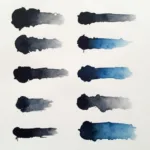Cranes, those majestic symbols of grace and longevity, often evoke images of pure white. But what color are cranes, really? The answer is more nuanced than you might think, encompassing a surprising range of hues and patterns depending on the species. Let’s delve into the fascinating world of crane coloration.
Decoding Crane Colors: From White to Gray and Beyond
While the iconic image of a crane is often a pristine white, many crane species sport a variety of colors. Some, like the Sandhill Crane, boast a predominantly gray plumage with reddish-brown accents, while others, like the Demoiselle Crane, exhibit striking contrasts of gray, black, and white. The Whooping Crane, North America’s tallest bird, is indeed primarily white, but with black wingtips that become visible in flight.
The Significance of Color in Cranes
Color plays a vital role in the lives of cranes, influencing everything from camouflage and mate attraction to species recognition. For instance, the subdued gray and brown tones of the Sandhill Crane provide excellent camouflage in their wetland habitats. Conversely, the vibrant colors and elaborate displays of some species, like the Sarus Crane, are crucial for courtship rituals.
What Influences Crane Coloration?
Several factors contribute to the diverse color palette seen across different crane species. Genetics, diet, and environmental factors all play a role. For example, some crane species acquire reddish-brown coloration from preening their feathers with iron-rich mud. This behavior is not only important for maintaining feather health but also contributes to their unique appearance.
Common Crane Color Patterns
- White: Often associated with purity and longevity, the white plumage is characteristic of species like the Whooping Crane and the Siberian Crane.
- Gray: Provides excellent camouflage in various habitats, seen in species such as the Sandhill Crane and the Common Crane.
- Black: Often found on wingtips, necks, or facial markings, black adds contrast and visual interest, as seen in the Whooping Crane and the Demoiselle Crane.
- Red: Vibrant red patches on the head and neck are often associated with courtship displays, as seen in the Sarus Crane and the Brolga.
Why Are Some Cranes White?
The white plumage of some crane species, like the Whooping Crane, serves multiple purposes. It can aid in thermoregulation by reflecting sunlight and keeping the birds cool in warmer climates. The brilliant white also enhances visibility during courtship displays, making it easier for potential mates to spot each other.
The Role of Molting in Crane Color Changes
Cranes, like many birds, undergo molting, the process of shedding old feathers and growing new ones. This process can sometimes lead to subtle changes in their coloration, particularly in younger birds as they transition to adult plumage.
 Crane Molting Process
Crane Molting Process
Conclusion: A Spectrum of Crane Colors
So, what color are cranes? The answer isn’t simply black and white. From the pristine white of the Whooping Crane to the subtle grays and browns of the Sandhill Crane, the world of crane coloration is a fascinating spectrum reflecting the diversity and adaptability of these remarkable birds. Understanding the nuances of crane coloration offers a deeper appreciation for their beauty and the intricate interplay of nature’s artistry. where is monte vista colorado
FAQ
- What is the tallest crane species? The Whooping Crane is the tallest North American bird.
- Are all cranes white? No, cranes come in a variety of colors including white, gray, black, and red.
- Why are some cranes red? Red coloration is often associated with courtship displays.
- What is molting in cranes? Molting is the process of shedding old feathers and growing new ones.
- What does crane color signify? Color in cranes plays a role in camouflage, mate attraction, and species recognition.
- Do cranes change color seasonally? While not drastic, some changes can occur during molting.
- How does diet affect crane color? Some cranes acquire reddish-brown coloration from preening with iron-rich mud.
When you need assistance, please contact us by Phone: 0373298888, Email: [email protected] Or visit us at: 86 Cầu Giấy, Hà Nội. We have a 24/7 customer service team.
